Finance Report: Financial Statement Analysis and Budgeting
VerifiedAdded on 2021/06/17
|7
|1444
|22
Report
AI Summary
This finance report provides a comprehensive overview of key financial concepts and analyses. It begins with an explanation of the balance sheet and its components, followed by a discussion of financial reporting and its various elements, including financial statements, media releases, and management analysis. The report then differentiates between profit and cash flow, highlighting their distinct characteristics and importance. It emphasizes the significance of maintaining daily financial records for effective business management, covering reasons such as monitoring financial health, controlling business activities, and meeting tax obligations. The report further identifies areas for monitoring business performance, including financial statements, ratios, and competitive analysis. The report includes examples of account types, profit and loss analysis, and budgeting, including variance analysis and sales budgeting for a restaurant. Finally, the report concludes with a list of relevant references.
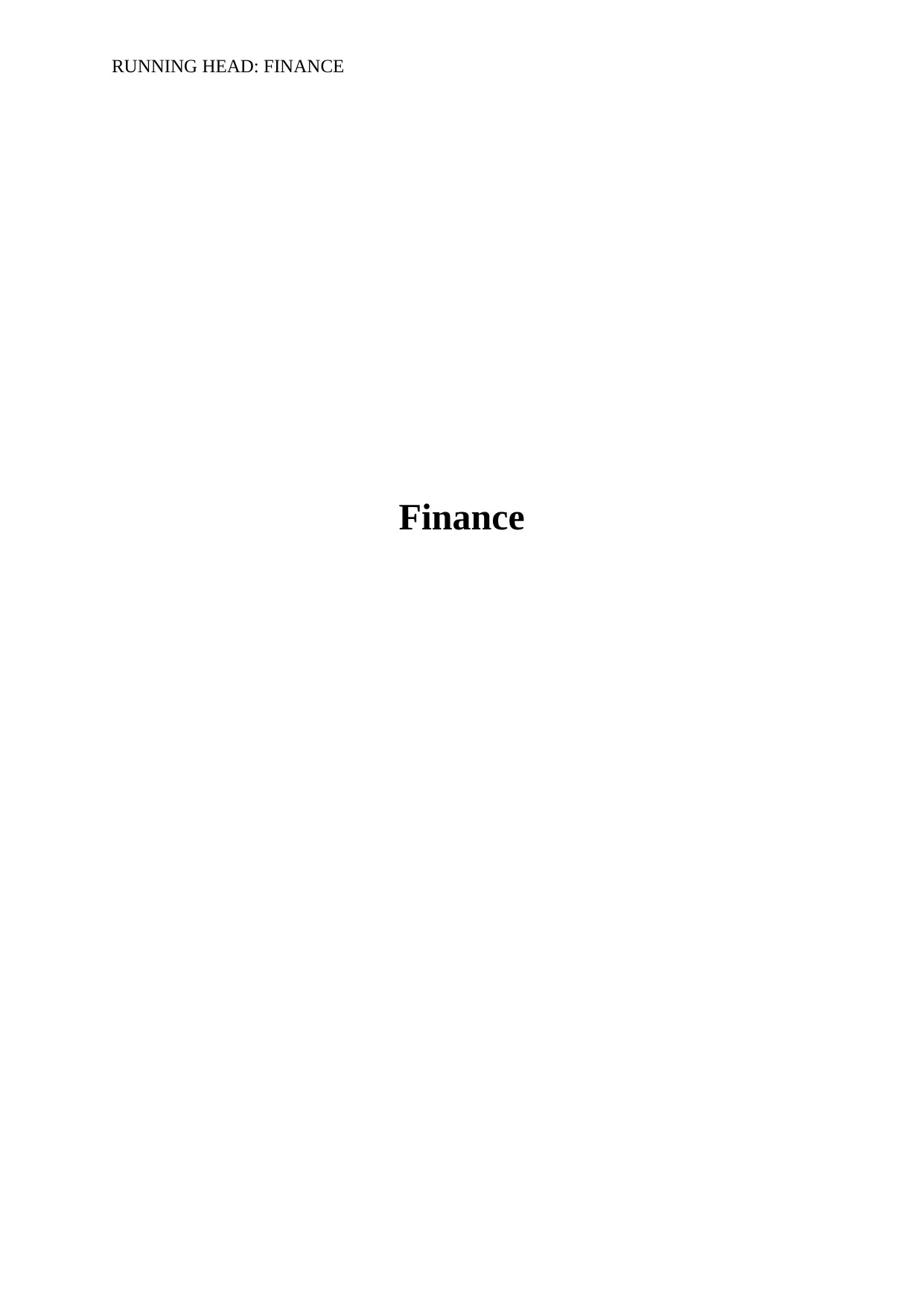
RUNNING HEAD: FINANCE
Finance
Finance
Paraphrase This Document
Need a fresh take? Get an instant paraphrase of this document with our AI Paraphraser

Finance
Task 1
a) Balance sheet
It is also known as statement of financial position that reflects the true and fair view of a
company’s financial position in the market. It is a statement that shows the balances of the
assets, liabilities and capital of a business reported at the end of a fiscal year. Balance sheet
reflects the capital structure of the firm and provides an idea about the company’s equity and
debt financing.1 The fundamental equation of a balance sheet is:
Assets = Liabilities + Equity
The statement is prepared at the end of every fiscal year along with other financial
statements. It is used by investors, shareholders, creditors and many other users to critically
evaluate the financial position of a company.
b) Financial reporting
Generally, following information is included while preparing financial reports of an
organization:
The financial statements that include cash flow statement, Profit and loss account,
statement of financial position and changes in equity. .
Notes to above financial statements are been disclosed in the financial report along
with the presentation of such accounts.
Media releases and announcements related to quarterly earnings.
Quarterly and annual reports provided to shareholders
Prospectus related to the issuance of public offering.
Analysis and discussion done by management2
All the above information are contained in a company’s financial report prepared by the
auditors and related expertise individual.
c) Difference between profit and cash flow
1 Thomas R Ittelson, Financial statements: A step-by-step guide to understanding and
creating financial reports (Red Wheel/Weiser 2009).
2Charles H Gibson, Financial reporting and analysis (13thedn, South-Western Cengage
Learning, 2011).
2
Task 1
a) Balance sheet
It is also known as statement of financial position that reflects the true and fair view of a
company’s financial position in the market. It is a statement that shows the balances of the
assets, liabilities and capital of a business reported at the end of a fiscal year. Balance sheet
reflects the capital structure of the firm and provides an idea about the company’s equity and
debt financing.1 The fundamental equation of a balance sheet is:
Assets = Liabilities + Equity
The statement is prepared at the end of every fiscal year along with other financial
statements. It is used by investors, shareholders, creditors and many other users to critically
evaluate the financial position of a company.
b) Financial reporting
Generally, following information is included while preparing financial reports of an
organization:
The financial statements that include cash flow statement, Profit and loss account,
statement of financial position and changes in equity. .
Notes to above financial statements are been disclosed in the financial report along
with the presentation of such accounts.
Media releases and announcements related to quarterly earnings.
Quarterly and annual reports provided to shareholders
Prospectus related to the issuance of public offering.
Analysis and discussion done by management2
All the above information are contained in a company’s financial report prepared by the
auditors and related expertise individual.
c) Difference between profit and cash flow
1 Thomas R Ittelson, Financial statements: A step-by-step guide to understanding and
creating financial reports (Red Wheel/Weiser 2009).
2Charles H Gibson, Financial reporting and analysis (13thedn, South-Western Cengage
Learning, 2011).
2
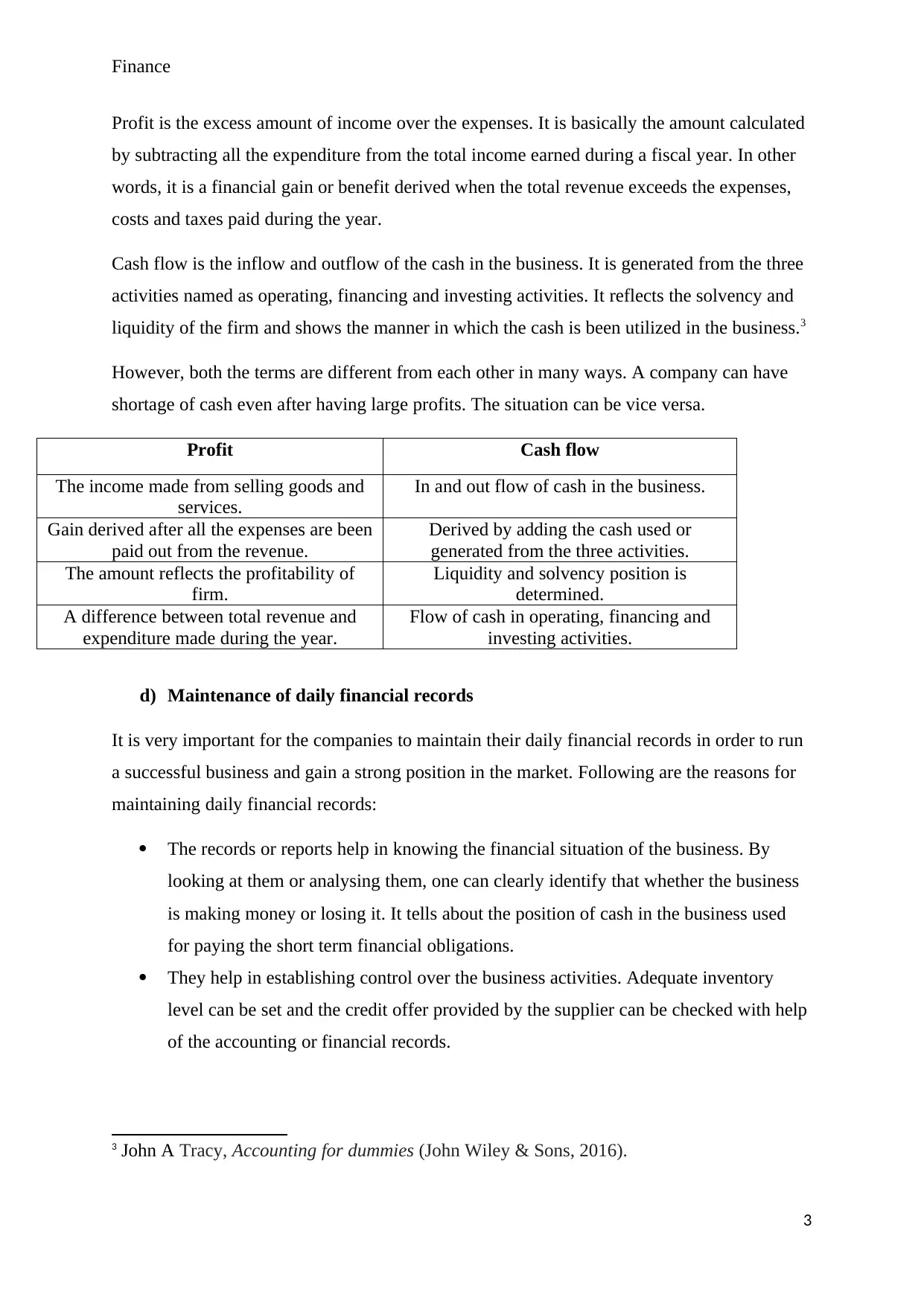
Finance
Profit is the excess amount of income over the expenses. It is basically the amount calculated
by subtracting all the expenditure from the total income earned during a fiscal year. In other
words, it is a financial gain or benefit derived when the total revenue exceeds the expenses,
costs and taxes paid during the year.
Cash flow is the inflow and outflow of the cash in the business. It is generated from the three
activities named as operating, financing and investing activities. It reflects the solvency and
liquidity of the firm and shows the manner in which the cash is been utilized in the business.3
However, both the terms are different from each other in many ways. A company can have
shortage of cash even after having large profits. The situation can be vice versa.
Profit Cash flow
The income made from selling goods and
services.
In and out flow of cash in the business.
Gain derived after all the expenses are been
paid out from the revenue.
Derived by adding the cash used or
generated from the three activities.
The amount reflects the profitability of
firm.
Liquidity and solvency position is
determined.
A difference between total revenue and
expenditure made during the year.
Flow of cash in operating, financing and
investing activities.
d) Maintenance of daily financial records
It is very important for the companies to maintain their daily financial records in order to run
a successful business and gain a strong position in the market. Following are the reasons for
maintaining daily financial records:
The records or reports help in knowing the financial situation of the business. By
looking at them or analysing them, one can clearly identify that whether the business
is making money or losing it. It tells about the position of cash in the business used
for paying the short term financial obligations.
They help in establishing control over the business activities. Adequate inventory
level can be set and the credit offer provided by the supplier can be checked with help
of the accounting or financial records.
3 John A Tracy, Accounting for dummies (John Wiley & Sons, 2016).
3
Profit is the excess amount of income over the expenses. It is basically the amount calculated
by subtracting all the expenditure from the total income earned during a fiscal year. In other
words, it is a financial gain or benefit derived when the total revenue exceeds the expenses,
costs and taxes paid during the year.
Cash flow is the inflow and outflow of the cash in the business. It is generated from the three
activities named as operating, financing and investing activities. It reflects the solvency and
liquidity of the firm and shows the manner in which the cash is been utilized in the business.3
However, both the terms are different from each other in many ways. A company can have
shortage of cash even after having large profits. The situation can be vice versa.
Profit Cash flow
The income made from selling goods and
services.
In and out flow of cash in the business.
Gain derived after all the expenses are been
paid out from the revenue.
Derived by adding the cash used or
generated from the three activities.
The amount reflects the profitability of
firm.
Liquidity and solvency position is
determined.
A difference between total revenue and
expenditure made during the year.
Flow of cash in operating, financing and
investing activities.
d) Maintenance of daily financial records
It is very important for the companies to maintain their daily financial records in order to run
a successful business and gain a strong position in the market. Following are the reasons for
maintaining daily financial records:
The records or reports help in knowing the financial situation of the business. By
looking at them or analysing them, one can clearly identify that whether the business
is making money or losing it. It tells about the position of cash in the business used
for paying the short term financial obligations.
They help in establishing control over the business activities. Adequate inventory
level can be set and the credit offer provided by the supplier can be checked with help
of the accounting or financial records.
3 John A Tracy, Accounting for dummies (John Wiley & Sons, 2016).
3
⊘ This is a preview!⊘
Do you want full access?
Subscribe today to unlock all pages.

Trusted by 1+ million students worldwide
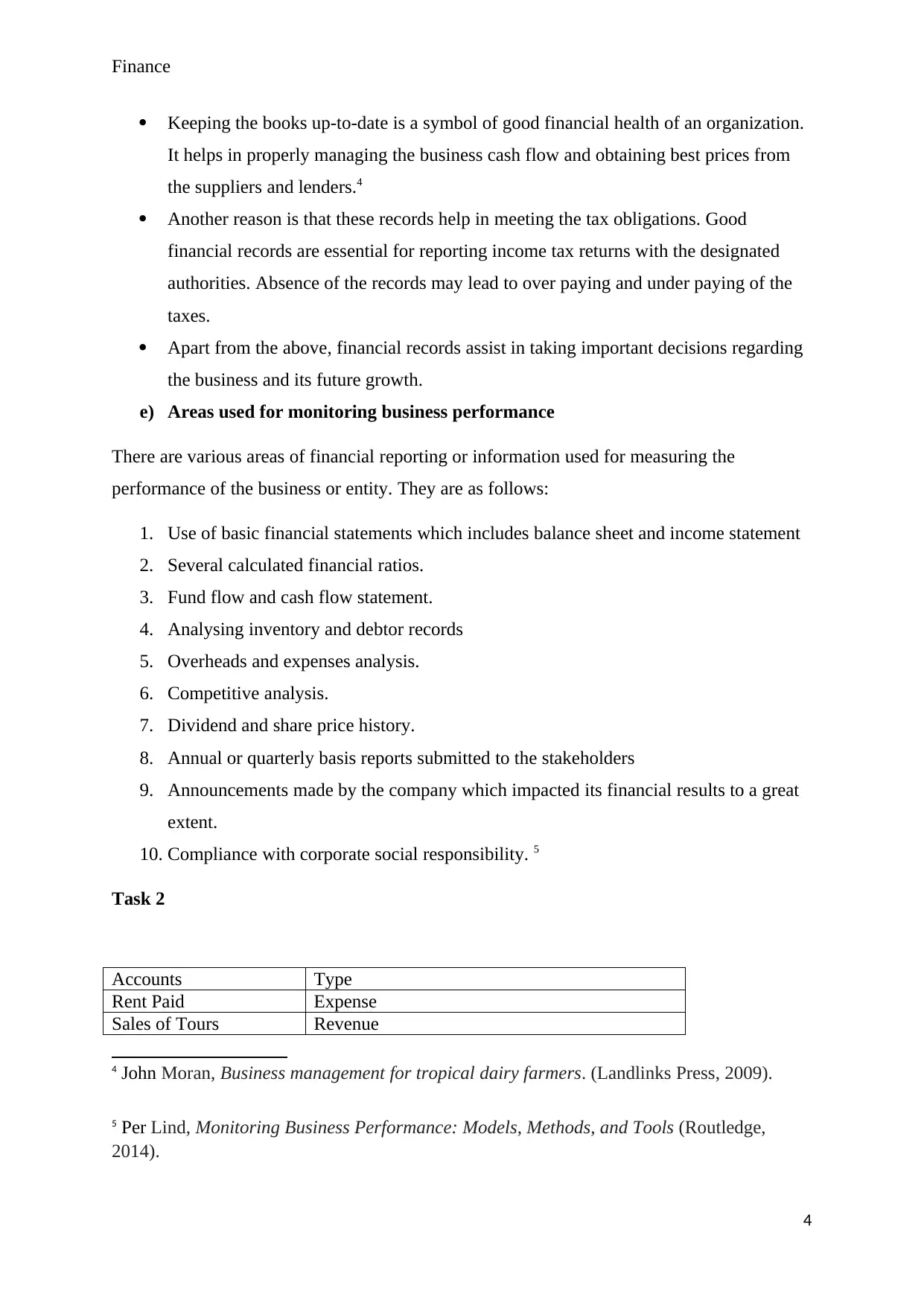
Finance
Keeping the books up-to-date is a symbol of good financial health of an organization.
It helps in properly managing the business cash flow and obtaining best prices from
the suppliers and lenders.4
Another reason is that these records help in meeting the tax obligations. Good
financial records are essential for reporting income tax returns with the designated
authorities. Absence of the records may lead to over paying and under paying of the
taxes.
Apart from the above, financial records assist in taking important decisions regarding
the business and its future growth.
e) Areas used for monitoring business performance
There are various areas of financial reporting or information used for measuring the
performance of the business or entity. They are as follows:
1. Use of basic financial statements which includes balance sheet and income statement
2. Several calculated financial ratios.
3. Fund flow and cash flow statement.
4. Analysing inventory and debtor records
5. Overheads and expenses analysis.
6. Competitive analysis.
7. Dividend and share price history.
8. Annual or quarterly basis reports submitted to the stakeholders
9. Announcements made by the company which impacted its financial results to a great
extent.
10. Compliance with corporate social responsibility. 5
Task 2
Accounts Type
Rent Paid Expense
Sales of Tours Revenue
4 John Moran, Business management for tropical dairy farmers. (Landlinks Press, 2009).
5 Per Lind, Monitoring Business Performance: Models, Methods, and Tools (Routledge,
2014).
4
Keeping the books up-to-date is a symbol of good financial health of an organization.
It helps in properly managing the business cash flow and obtaining best prices from
the suppliers and lenders.4
Another reason is that these records help in meeting the tax obligations. Good
financial records are essential for reporting income tax returns with the designated
authorities. Absence of the records may lead to over paying and under paying of the
taxes.
Apart from the above, financial records assist in taking important decisions regarding
the business and its future growth.
e) Areas used for monitoring business performance
There are various areas of financial reporting or information used for measuring the
performance of the business or entity. They are as follows:
1. Use of basic financial statements which includes balance sheet and income statement
2. Several calculated financial ratios.
3. Fund flow and cash flow statement.
4. Analysing inventory and debtor records
5. Overheads and expenses analysis.
6. Competitive analysis.
7. Dividend and share price history.
8. Annual or quarterly basis reports submitted to the stakeholders
9. Announcements made by the company which impacted its financial results to a great
extent.
10. Compliance with corporate social responsibility. 5
Task 2
Accounts Type
Rent Paid Expense
Sales of Tours Revenue
4 John Moran, Business management for tropical dairy farmers. (Landlinks Press, 2009).
5 Per Lind, Monitoring Business Performance: Models, Methods, and Tools (Routledge,
2014).
4
Paraphrase This Document
Need a fresh take? Get an instant paraphrase of this document with our AI Paraphraser
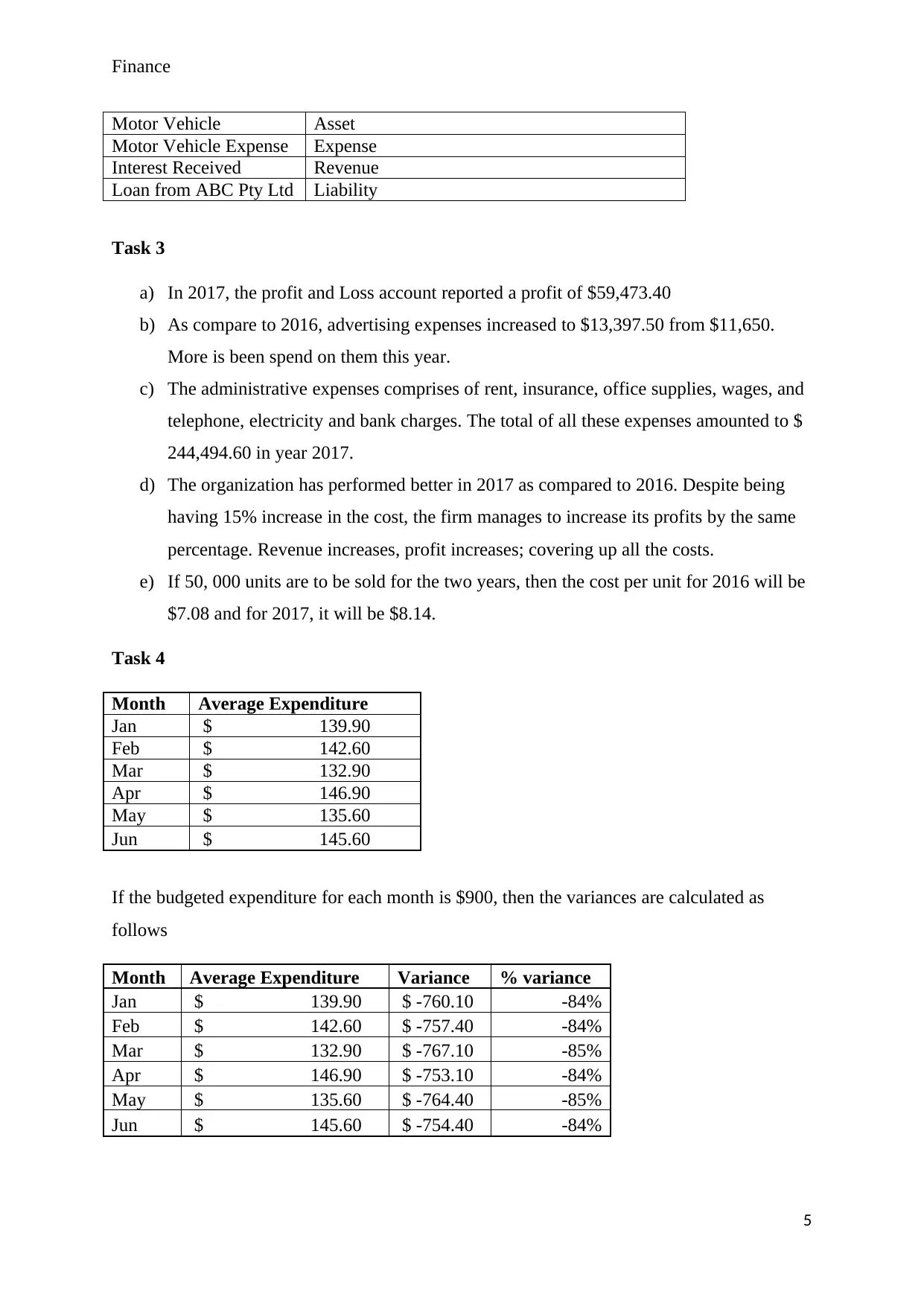
Finance
Motor Vehicle Asset
Motor Vehicle Expense Expense
Interest Received Revenue
Loan from ABC Pty Ltd Liability
Task 3
a) In 2017, the profit and Loss account reported a profit of $59,473.40
b) As compare to 2016, advertising expenses increased to $13,397.50 from $11,650.
More is been spend on them this year.
c) The administrative expenses comprises of rent, insurance, office supplies, wages, and
telephone, electricity and bank charges. The total of all these expenses amounted to $
244,494.60 in year 2017.
d) The organization has performed better in 2017 as compared to 2016. Despite being
having 15% increase in the cost, the firm manages to increase its profits by the same
percentage. Revenue increases, profit increases; covering up all the costs.
e) If 50, 000 units are to be sold for the two years, then the cost per unit for 2016 will be
$7.08 and for 2017, it will be $8.14.
Task 4
Month Average Expenditure
Jan $ 139.90
Feb $ 142.60
Mar $ 132.90
Apr $ 146.90
May $ 135.60
Jun $ 145.60
If the budgeted expenditure for each month is $900, then the variances are calculated as
follows
Month Average Expenditure Variance % variance
Jan $ 139.90 $ -760.10 -84%
Feb $ 142.60 $ -757.40 -84%
Mar $ 132.90 $ -767.10 -85%
Apr $ 146.90 $ -753.10 -84%
May $ 135.60 $ -764.40 -85%
Jun $ 145.60 $ -754.40 -84%
5
Motor Vehicle Asset
Motor Vehicle Expense Expense
Interest Received Revenue
Loan from ABC Pty Ltd Liability
Task 3
a) In 2017, the profit and Loss account reported a profit of $59,473.40
b) As compare to 2016, advertising expenses increased to $13,397.50 from $11,650.
More is been spend on them this year.
c) The administrative expenses comprises of rent, insurance, office supplies, wages, and
telephone, electricity and bank charges. The total of all these expenses amounted to $
244,494.60 in year 2017.
d) The organization has performed better in 2017 as compared to 2016. Despite being
having 15% increase in the cost, the firm manages to increase its profits by the same
percentage. Revenue increases, profit increases; covering up all the costs.
e) If 50, 000 units are to be sold for the two years, then the cost per unit for 2016 will be
$7.08 and for 2017, it will be $8.14.
Task 4
Month Average Expenditure
Jan $ 139.90
Feb $ 142.60
Mar $ 132.90
Apr $ 146.90
May $ 135.60
Jun $ 145.60
If the budgeted expenditure for each month is $900, then the variances are calculated as
follows
Month Average Expenditure Variance % variance
Jan $ 139.90 $ -760.10 -84%
Feb $ 142.60 $ -757.40 -84%
Mar $ 132.90 $ -767.10 -85%
Apr $ 146.90 $ -753.10 -84%
May $ 135.60 $ -764.40 -85%
Jun $ 145.60 $ -754.40 -84%
5

Finance
It can be seen that in every month, the actual average expenditure is very much lower than the
budgeted expense of $900 per month. According to the report, March and May has the lowest
expenditure average. Among these two, the month having least expenditure is March with
$132.90. As per this, March should be investigated more deeply in order to find out the
reason of the 85% variance and reasons for low expenditure.
Task 5
Sales budget for the restaurant
Number of customers = Daily seat turnover X Number of seats6
Daily seat turnover 1.2
Number of seats 175
Number of
customers 210
The average check for the restaurant was $17.00 in the year and for the coming year, it is
forecasted to increase by 25%. The sales budget for the next year will be as follows:
Average check $ 21.25
Number of
customers 210
Daily revenue $ 4,462.50
Weekly revenue $ 26,775.00
Yearly revenue $ 1,392,300.00
Notes:
It is assumed that the number of customers will remain the same in the next year.
The yearly revenue is calculated by multiplying weekly revenue with 52 weeks.
Daily revenue is multiplied by the number of days a restaurant operates in order to
calculate the weekly sales.
The restaurant operates 6 days in a week having 175 seats in total.
Bibliography
6 Chris Guilding, Accounting essentials for hospitality managers (3rdedn, Routledge, 2014).
6
It can be seen that in every month, the actual average expenditure is very much lower than the
budgeted expense of $900 per month. According to the report, March and May has the lowest
expenditure average. Among these two, the month having least expenditure is March with
$132.90. As per this, March should be investigated more deeply in order to find out the
reason of the 85% variance and reasons for low expenditure.
Task 5
Sales budget for the restaurant
Number of customers = Daily seat turnover X Number of seats6
Daily seat turnover 1.2
Number of seats 175
Number of
customers 210
The average check for the restaurant was $17.00 in the year and for the coming year, it is
forecasted to increase by 25%. The sales budget for the next year will be as follows:
Average check $ 21.25
Number of
customers 210
Daily revenue $ 4,462.50
Weekly revenue $ 26,775.00
Yearly revenue $ 1,392,300.00
Notes:
It is assumed that the number of customers will remain the same in the next year.
The yearly revenue is calculated by multiplying weekly revenue with 52 weeks.
Daily revenue is multiplied by the number of days a restaurant operates in order to
calculate the weekly sales.
The restaurant operates 6 days in a week having 175 seats in total.
Bibliography
6 Chris Guilding, Accounting essentials for hospitality managers (3rdedn, Routledge, 2014).
6
⊘ This is a preview!⊘
Do you want full access?
Subscribe today to unlock all pages.

Trusted by 1+ million students worldwide
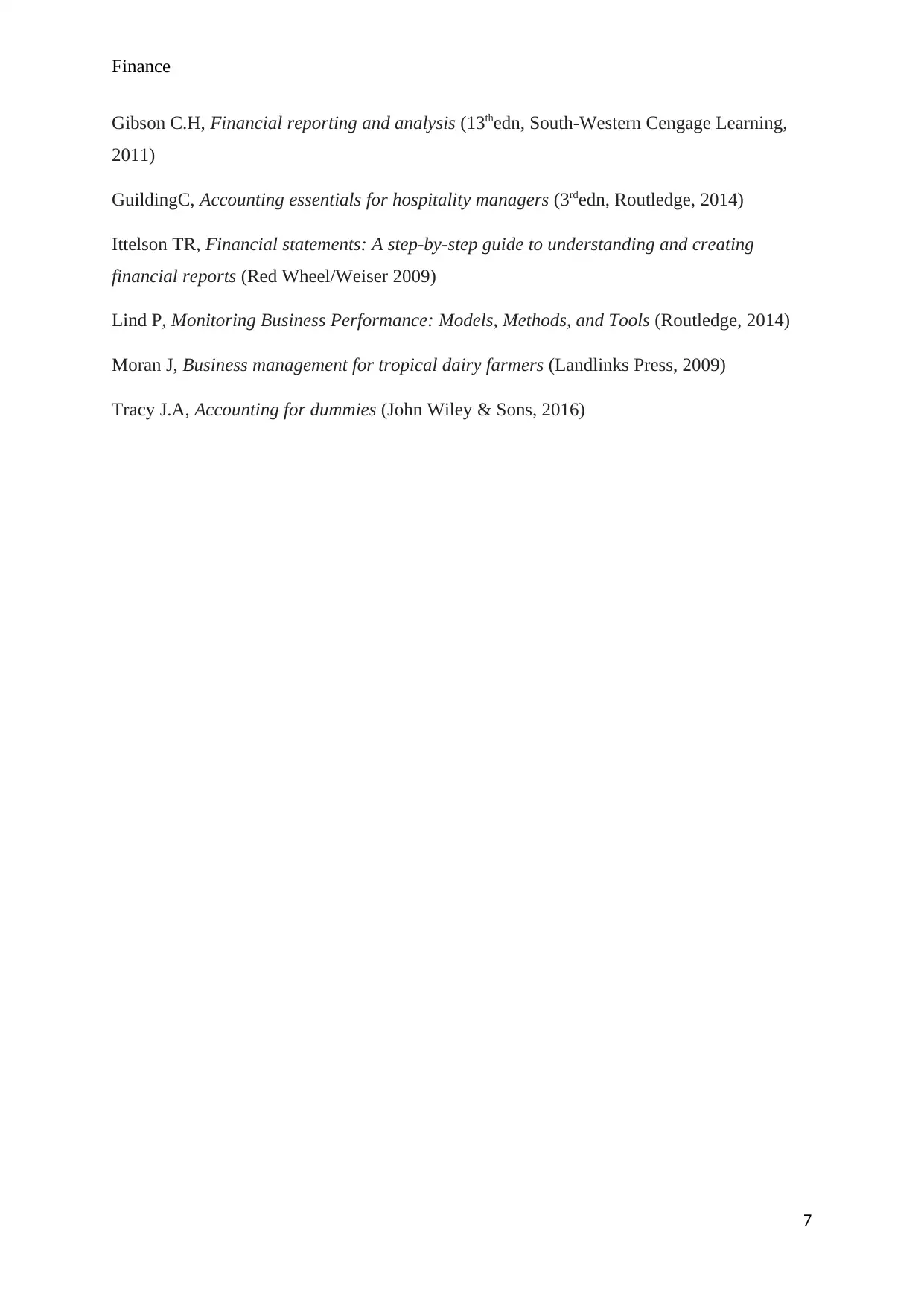
Finance
Gibson C.H, Financial reporting and analysis (13thedn, South-Western Cengage Learning,
2011)
GuildingC, Accounting essentials for hospitality managers (3rdedn, Routledge, 2014)
Ittelson TR, Financial statements: A step-by-step guide to understanding and creating
financial reports (Red Wheel/Weiser 2009)
Lind P, Monitoring Business Performance: Models, Methods, and Tools (Routledge, 2014)
Moran J, Business management for tropical dairy farmers (Landlinks Press, 2009)
Tracy J.A, Accounting for dummies (John Wiley & Sons, 2016)
7
Gibson C.H, Financial reporting and analysis (13thedn, South-Western Cengage Learning,
2011)
GuildingC, Accounting essentials for hospitality managers (3rdedn, Routledge, 2014)
Ittelson TR, Financial statements: A step-by-step guide to understanding and creating
financial reports (Red Wheel/Weiser 2009)
Lind P, Monitoring Business Performance: Models, Methods, and Tools (Routledge, 2014)
Moran J, Business management for tropical dairy farmers (Landlinks Press, 2009)
Tracy J.A, Accounting for dummies (John Wiley & Sons, 2016)
7
1 out of 7
Related Documents
Your All-in-One AI-Powered Toolkit for Academic Success.
+13062052269
info@desklib.com
Available 24*7 on WhatsApp / Email
![[object Object]](/_next/static/media/star-bottom.7253800d.svg)
Unlock your academic potential
Copyright © 2020–2025 A2Z Services. All Rights Reserved. Developed and managed by ZUCOL.





